Museum De Lakenhal, Leiden, Netherlands
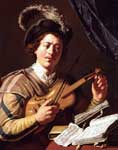
The Violin Player, Jan Lievens
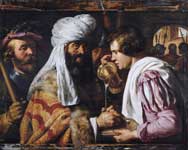
Pilate Washing his Hands, Jan Lievens
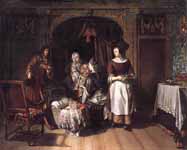
Visit to the Nursery, Matthijs Naiveu
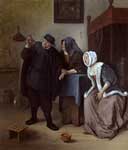
De Piskijker, Jan Steen
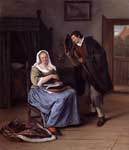
De Koekvrijer, Jan Steen
Museum De Lakenhal, Stedelijk Museum De Lakenhal, Leiden
Museum De Lakenhal is a city museum of history and fine art in Leiden, Netherlands. One highlight is its collection of fijnschilder paintings from the Dutch Golden Age. The museum regularly hosts visiting art exhibitions and has a café.
The museum today
History of the building
The museum building was erected in 1640 by Arent van 'Gravesande as a cloth hall (lakenhal in Dutch) – a guild hall for cloth merchants.[1] The museum was founded in 1874 as a stedelijk museum (municipal museum)
Museum entrance in the former Cloth Hall - 1642 painting by the Leiden architectural painter Susanna van Steenwijk. The eastern expansion had not yet been realized.
Collections
Like other municipal museums in the Netherlands, it became a repository for municipal art collections. Artifacts from Leiden are on display such as a series of stained glass windows by Willem Thibaut commissioned for the Leiden city hall, are now installed in the stairwells.
On permanent display is also the old inspection room or Staalmeesterskamer where cloth was inspected and the meeting hall where disputes were decided. Four large paintings depicting the cloth industry by Isaac van Swanenburg hang in the same spots on the walls as designed. Similarly, a very grand over-the-mantel piece by Carel de Moor shows the inspectors in a massive wooden frame decorated with their family shields, flanked by a series of three historical allegories of the city of Leiden by Abraham Lambertsz van den Tempel.
The museum hosts a collection of altarpieces and religious artifacts from before the Protestant Revolution that were formally ceded to the state in 1572. The museum also includes a reconstructed statie or Catholic mission station from after the Reformation. Because the Catholic religion was banned, there was no official church and all of the Catholic places of worship in the young Dutch Republic were called mission stations. These were semi-hidden churches that were tolerated and taxed by the state.
Minerva Crowns the Maid of Leiden, one of a series of three grand paintings for the Lakenhal in 1650 by Abraham Lambertsz van den Tempel.
References
"History of De Lakenhal". Museum De Lakenhal. Retrieved 1 May 2013.
----
Fine Art Prints | Greeting Cards | Phone Cases | Lifestyle | Face Masks | Men's , Women' Apparel | Home Decor | jigsaw puzzles | Notebooks | Tapestries | ...
----
Artist
A - B - C - D - E - F - G - H - I - J - K - L - M -
N - O - P - Q - R - S - T - U - V - W - X - Y - Z
Retrieved from "http://en.wikipedia.org/"
All text is available under the terms of the GNU Free Documentation License


